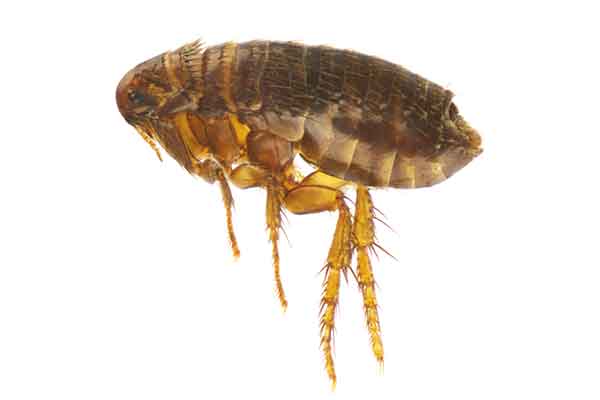
Fleas are the most annoying pests among all blood-sucking pests. They are well known for their agility in which they are able to jump like 50 times more than their body length. They are mostly shiny brown in colour and feed on sucking blood from any warm-blooded mammals especially four-legged ones.
Adult fleas are about 2.5mm long which makes them visible to the naked eye. They are small but not hard to see.
The only thing that makes them hard to see is that by the time you try to catch them, they will be long gone. Fleas cannot fly but they jump so fast and long that you’d bet they have wings.
Fleas like humid and warm areas so make sure you clear such areas at your home.
To keep fleas away, you must also make sure to mow your lawn regularly and rake it thoroughly because fleas also take shelter in the long grass. If you mow the lawn without raking afterwards you will also be inviting fleas to your place as they will take shelter in the mowed debris.
Also, it is better to bag all the grass you mowed instead of disposing of them on your compost heap as there might be fleas inside.
Make sure to remove dried twigs, dead leaves or rubbish in your flower beds because these can pose as perfect homes for fleas.
You can go to a garden store and ask for nematodes, some small worms that eat parasitic eggs and put them in your flower beds to prevent fleas from laying eggs there.
Make sure you keep your place clean, repair cracks that might make hiding places for fleas and clean your pets’ habitats and bedding so that fleas won’t find favourable conditions in your home or your pets’ homes.
Bath your pets with flea shampoo especially dogs because they are the ones that mostly carry fleas into your home.
Have a flea comb for your pets too so that you comb them regularly to see if there are any fleas in their fur.
Habits of fleas
Fleas prefer four-legged hosts to humans. They prefer animals because they can hide perfectly in the fur.
Fleas like warm temperatures that are about 26 to 32°C(80-90°F) with 70 per cent humidity so make sure you clear all warm humid areas in your home.
Fleas have an 18-21days life cycle and the adult ones can live up to several weeks or months.
Larvae can remain dormant for some weeks in unfavourable conditions waiting for conditions to be favourable so that they can transform into a pupa.
Damages caused by fleas
Fleas are dangerous in that they spread diseases like flea-borne typhus and bubonic plague.
Bubonic plague is most common in rats but it is believed that rats get this disease from fleas.
If you happen to have rats as pests, the possibility of them having fleas are very high and you are at great risk of getting this plague.
If undetected for a long time, fleas can cause heartworm and tapeworm in pets. Tapeworms can affect people too so it is better to make sure your home is clear of these bugs so as to stay safe from these diseases.
It is also recommended to check your pets and your surroundings for any fleas so that you won’t realize their infestation when its already too late
Fleas also cause itching in humans and allergic reactions due to flea bites. If scratched too much, the itching parts can tear off leaving the space prone to bacterial infections. So make sure to treat flea bites without aggressive scratching and in the event of any tearing of the skin, put some antibiotics on the area and cover it if possible.
How to detect fleas in your home
If you experience constant itching then you should look out for fleas in your home.
You might not see the fleas most of the time because by the time you try to find out what has caused the itching it would have already leapt away.
Use a flea comb on your pests to see if there are any fleas in their fur
You can also see the presence of fleas in your home by encountering their eggs, larvae and cocoons throughout your house or where your pets usually hang out.
If you inspect carefully the places where your pets sleep or play you can find some adult fleas there too.
Human Fleas Removal
If you detect any signs of fleas in your home then treat your pets and their habitats with immediate effect.
Vacuum your floors, upholstery and mattresses and if possible use a bag that you won’t have to reuse again so that you can throw it away with the fleas inside.
Clean your bedding as well as your pets’ and if the fleas are too much it’s better to throw away or even burn the old bedding and replace it with a new one.
Use pesticides to kill the fleas and aerosol sprays are mostly recommended because they can reach some places where foggers might not reach.
Make sure to use pesticides that can kill fleas from all stages of their lives. Find pesticides with permethrin that kills adult fleas and growth regulators like methoprene or pyriproxyfen for flea eggs, larvae and pupae.
Also, wash your clothes and bedding as well as your pets’ with hot water so as to kill the fleas or their eggs.
If any of these doesn’t effectively eradicate fleas in your home then contact your local pest control services to deal with the matter.
I would have suggested squashing the fleas but that task is almost impossible as those little jumpers are very difficult to catch.
